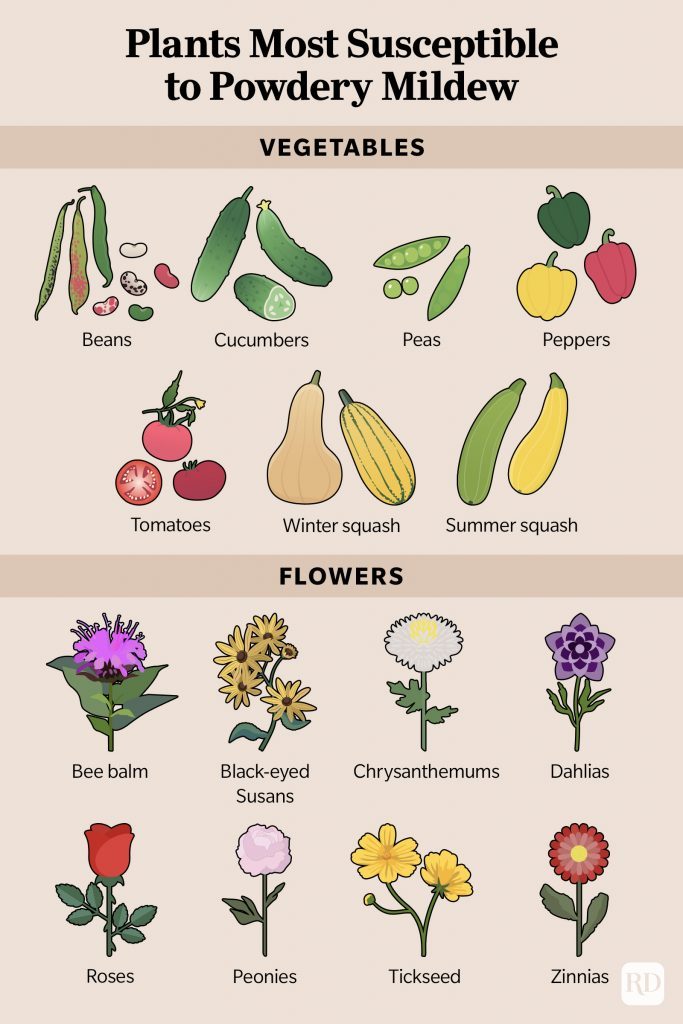Gardening is full of rewards. But sometimes, regardless of whether you’re a novice or a pro, you’ll come across issues in the landscape. Powdery mildew on plants — a white fuzz that usually appears on leaves and sometimes on the stem, flowers or fruit — is a common ailment.
“The upper leaf surfaces will have a powdery white-gray mildew growing on [them] that is relatively easy to wipe away with a finger,” says Sam Schmitz, a horticulturist with Ball Horticultural Company.
Although powdery mildew usually occurs on the upper leaf surfaces, the whole plant can be affected. However, when caught early, this disease is easy to stop.
What is powdery mildew?
“Powdery mildew is actually an umbrella term for a wide range of fungi that cause similar symptoms, such as fuzzy powder on leaves,” says Jessie Liebenguth, a horticulturist with Reiman Gardens at Iowa State University. “Because there are multiple fungi that cause powdery mildew, nearly all plants can be affected.”
Powdery mildew can go unnoticed until the environment is just right. “The spores that cause powdery mildew can be present even if the plant isn’t showing signs,” says Lindsay Pangborn, a gardening expert with Bloomscape.
What’s the optimal environment for growth? “Shade, poor air circulation, high humidity, and moderate temperatures are favorable conditions for powdery mildew to develop,” Liebenguth says.
Spores can be carried by the wind, water and even insects. In an ideal environment, white powder on plants will flourish quickly.
While all plants can develop powdery mildew, some are more susceptible than others, and some cultivars are bred to resist it. The list below will give you a good idea of the plants most likely to acquire the fungal disease.

Vegetables most likely to develop powdery mildew
- Beans;
- Cucumbers;
- Peas;
- Peppers;
- Tomatoes;
- Winter squash;
- Summer squash/zucchini.
Flowers most likely to develop powdery mildew
- Bee balm;
- Black-eyed Susans;
- Chrysanthemums;
- Dahlias;
- Roses;
- Peonies;
- Tickseed;
- Zinnias.
What are signs of powdery mildew on your plants?
Powdery mildew is obvious when it begins appearing on the leaves.
“Powdery mildew is usually seen on the broadest sections of the plants, starting out as small, white, circular spots or discoloration on the plant’s leaves,” Pangborn says. “In its more developed stages, it will completely cover the leaf in a white or gray cast, and the leaf itself will begin to turn brown.”
Once you see powdery mildew on plants, take steps to halt its growth. “It harms the plants by shading the leaf surfaces and preventing them from being able to photosynthesize,” says Schmitz. “These leaves can start to become a drain on the plant’s resources rather than contributing to the plant’s overall health.”
Can powdery mildew spread to other plants?
Powdery mildew can spread to the same type or variety of a plant. So if you have several zucchini plants growing in the garden and one has powdery mildew, the other zucchini plants will probably be affected in a short time. Other types of plants will probably be fine.
“Since powdery mildew cannot spread between different plants, it likely won’t take over your entire garden unless you have a monoculture,” says Liebenguth.
How do you get rid of powdery mildew?
There are different ways to minimize and eliminate powdery mildew. “The earlier the infection is treated, the better the chances of recovery,” says Pangborn.
As soon as you see powdery mildew on your plants, take the actions below.
Prune the plant
“Pruning off dead leaves and stems, removing them immediately so the spores don’t further spread, is the best first step,” says Pangborn. This will improve airflow. As you prune, disinfect your gardening tools to avoid spreading the spores to other plants.
Wash with a dish soap solution
Once you provide more airflow to the plants, Schmitz recommends washing the surface of the leaves with a mixture of water and mild dish soap.
Use a natural solution
Skip the chemical-based methods and go for non-toxic options.
“Most fungicides are preventative rather than curative, so by the time powdery mildew symptoms appear, it will be ineffective to apply a fungicide,” Liebenguth says. “Natural remedies for powdery mildew include a baking soda or potassium bicarbonate solution, a neem or horticultural oil application, or removing infected parts of plants from the garden.”
Remove infected leaves and plant parts
When removing parts of a plant with powdery mildew, don’t toss them in the compost bin. “Composting will not kill the pathogens,” says Liebenguth. According to Pangborn, the spores can survive composting process, leading to issues when the compost is used in the garden.
Instead, Pangborn recommends “burning infected leaves and stems, if possible, or bagging and discarding them.”
How can you prevent powdery mildew?
There’s no foolproof way to prevent powdery mildew on plants. A good starting point? Consider the needs of each plant. “Try not to get the leaves wet when watering plants, and encourage airflow by not placing plants too close together,” says Pangborn.
When powdery mildew does appear, it’s important to properly eliminate the affected plants. “If infected leaves and stems are removed and properly disposed of, there’s a good chance those powdery mildew spores won’t make a comeback the following year,” says Pangborn. “However, spores can blow in from anywhere, so unfortunately there’s no surefire way to avoid it from year to year.”
Article source here: If You See Powdery Mildew on Your Plants, This is What it Means


No comments:
Post a Comment